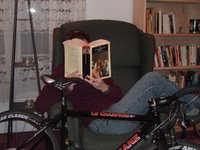Cross-posted at A Curious Singularity
I have a copy of Kafka's Complete Stories; it's been sitting on my shelf for quite a while, and I'm not sure if I'll ever read all the stories in it, but I would like to read more, as I enjoyed "A Hunger Artist." I feel like I've read a lot of Kafka, but when I think about what, exactly, I've read, I realize it's only The Trial, and that I read over a decade ago. Maybe I've read a lot about Kafka and that makes me feel like I've actually read a lot of his work. The term "kafka-esque" is very easy to throw around in conversation, and so it's not hard to begin to think I've got him all figured out.
I don't think I've got him all figured out, but "A Hunger Artist" didn't upset my expectations of what I'd find in a Kafka short story -- you could call it "kafka-esque": it feels like a parable; it deals with ideas as least as much as characters and more so than plot; it's absurd, and yet the story is told as though it weren't; it's about darkness and suffering and yet there's something fine and admirable about it.
At the center of the story is the paradox of the "hunger artist" himself -- how can one be a hunger artist? What's artistic about not eating? The narrator tells us the hunger artist believes in "the honor of his profession," and we learn that no one but the hunger artist can know for sure he is not cheating, so "he was therefore bound to be the sole completely satisfied spectator of his own fast." So there is something mysteriously artistic about fasting, and not only that, but the hunger artist is the only one who really understands it. He also says that although no one else knows it, fasting is easy, further undermining the "artistic" element of it. And there's the twist at the end where we learn that he fasts because he can't find food he likes to eat. So in what sense is fasting artistic?
I don't know, really, but it defines art as a complex give and take between artist and viewer. The artist knows fasting is easy, but the viewers won't believe it, so they insist that they are witnessing an act in one sense or another -- the artist is either "out for publicity or else was some kind of cheat who found it easy to fast because he had discovered a way of making it easy," i.e., he managed to sneak food into his cage. So part of the "art" is simply doing nothing and then letting viewers make what sense of it they will. The more the artist insists he's doing nothing, the more "artistic," partly as in "artifice" and "artificial," the viewers think it is.
Art in this story is nothing -- it's negation and refusal. It's about letting the body waste away, until it disappears at the story's end. And yet the art is nothingness that creates an event. It's a refusal of the body that's also a display of that body -- a weird denial of and celebration of the body. If art here is about nothing, it's also about death -- the artist makes his living off of dying.
No wonder taste is changing and people pass him by to head for the menagerie, and no wonder they prefer to see the panther, so full of the joy of life. And yet I don't think the story is leading us to sympathize with this changing taste; the hunger artist seems to be an admirable figure, and the people who refuse to appreciate him are refusing to see something real and true about life. It's like the hunger artist is the one who can recognize the true nature of things -- that everything ends in death and nothingness. He is an artist because of the way, simply by placing himself in a cage and refusing to eat, he can turn nothing into something -- he makes some kind of meaning, difficult and distressing though it may be, out of emptiness.



|